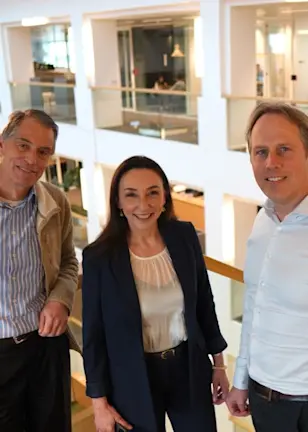The 2024 Robeco Global Climate Investing Survey of 300 institutional and wholesale investors provided fascinating insights into the state of play of climate investing. Some 62% of investors see climate change as being central to their investment policies, and 69% have a net-zero commitment, or are in the process of making one.
It means that investors’ commitments have held strong, in spite of a widespread realization that the policy momentum is weakening: 49% of investors think that the climate transition will be ‘too little, too late’, and 41% believe that the goals of the Paris agreement are no longer achievable.
This may appear as a contradiction, but when looking at investors’ plans for capital allocation, it starts to make more sense. Traditionally, allocations to low-carbon strategies and climate solutions have dominated the approach to climate investing. But there is a new kid on the block: 63% of investors are (or will be) allocating capital to transition strategies, focusing on high-emitting companies with credible plans to lower those emissions. This is shown in the chart below:

Source: Robeco Global Climate Investing Survey, May 2024
What is transition investing?
Transition investing targets companies who may be at the beginning of this journey to combat climate change. Historically, policies on transition financing differed from region to region, leading to inconsistent definitions and unclear labels for investments.
This meant that it was safest to focus on financed emissions as a core metric in portfolios, leading many institutional investors to steer away from carbon-intensive industries. This reduced accounted emissions in portfolios, but not necessarily real-world emissions.
And despite massive commitments to net zero from governments, industry and investors worldwide (equivalent to 92% of global GDP), real-world emissions have continued to rise. So while net zero continues to be the horizon, the immediate job at hand is to support and accelerate climate action by high-emitting companies. In other words: climate transition finance.
Measuring climate transition finance
The need to define transition finance was addressed by a G20 report highlighting 22 high-level principles for transition finance.1 The International Capital Market Association (ICMA) subsequently updated its Climate Transition Finance Handbook to include guidance for issuers in the ‘hard-to-abate’ sectors and extend the existing Green, Social and Sustainable (GSS) Bond Framework to facilitate transition financing.
This guidance is critical because transition finance comes with a significant risk of greenwashing. The guidance from authorities and market standards bodies emphasizes the need for robust measurement of the ambition, intentionality and credibility of company transition plans.
At Robeco, we have operationalized this in three measures which help to identify eligible investments supporting the concept. These are climate transition leaders, climate solutions providers, and GSS bonds. Let’s deal with each one in turn.
Climate transition leaders
We identify these companies through our Climate Traffic Light assessment of their degree of alignment with the goals of the Paris Agreement, taking into consideration the common but differentiated responsibilities of different nations.
The degree of alignment is determined by assessing two questions. The first is to ask whether the company’s projected emissions are in line with its required sector decarbonization pathway under a well below 2 °C scenario, regionally adjusted where needed. The second is to find out if the company has verified credible targets for achieving its emission-reduction plans.
The chart below shows the traffic light distribution per sector based on its market weight in the MSCI World Index. From this perspective, a large part of the index appears to be well in line with the Paris Agreement – it’s largely green.

Source: Robeco, July 2024
But what matters for the climate transition are the carbon-intensive sectors. So, the second chart shows the same numbers, but now weighted by their carbon footprints. This time it becomes very clear that misaligned and partially aligned companies are dominating the index in terms of climate impact. They are concentrated in the high-emission sectors, and so an increased effort should be made to bring these into alignment.

Source: Robeco, July 2024
It’s a similar story in the bond market. The charts below show the traffic light distribution for the same sectors but compared with the Bloomberg Global Aggregate Bond Index. The first chart shows sector distribution by market weight and the second by carbon footprint.

Source: Robeco, July 2024

Source: Robeco, July 2024
Climate solution providers
These are companies providing solutions to enable climate change mitigation. They are often found in industrial sectors and therefore may have reasonably high-carbon-intensive processes. The Intergovernmental Panel on Climate Change (IPCC) and International Energy Agency (IEA) both provide lists of which technologies, activities and services can substantially contribute to mitigating climate change and thus constitute climate solutions.
Jurisdictions like the EU and the Monetary Authority of Singapore are establishing taxonomies to identify activities which they see as contributing significantly to climate change mitigation and adaptation, both of which can be considered climate solutions.
GSS bonds
For fixed income investors, various instruments and types are available to help finance the transition. Our focus is on green bonds, where the proceeds will be exclusively applied to finance eligible climate projects. To combat greenwashing, Robeco has developed a proprietary five-step analysis to properly conduct selection and monitoring of GSS bonds.
The analysis is designed to ensure that only those GSS bonds that adhere to internationally accepted principles and which truly have an impact are eligible for the portfolio. The analysis is in line with the most recent regulatory developments on sustainable finance and applies to both corporate and government bonds.
Transition means exactly that
So, where to look for opportunities? Many companies are taking steps to transition their business models toward low carbon, but may lack in ambition or in delivery, earning an amber traffic light. We believe that transition strategies should also selectively invest in these companies, combined with active engagement to accelerate and enhance the company’s transition plan.
Our stewardship strategy focuses on material sustainability issues, which provides additional insights for portfolio construction. It’s a win-win: aiding organizations in adopting good transition practices while deepening our understanding of each industry’s unique challenges and opportunities.
Engaging with public and private entities and with policymakers on their transition plans keeps us at the forefront of this changing landscape. This in turn provides us with information to refine our assessments and generate alpha. Our approach to transition brings insight and foresight; incorporating these into our portfolios should bring impact and returns.
This article is an excerpt of a special topic in our five-year outlook.
最新のインサイトを受け取る
投資に関する最新情報や専門家の分析を盛り込んだニュースレター(英文)を定期的にお届けします。
Footnote
1 https://g20sfwg.org/wp-content/uploads/2022/10/2022-G20-Sustainable-Finance-Report-2.pdf
Webinar: 5-Year Expected Returns 2025-2029
Our five-year outlook on market opportunities and risks.
重要事項
当資料は情報提供を目的として、Robeco Institutional Asset Management B.V.が作成した英文資料、もしくはその英文資料をロベコ・ジャパン株式会社が翻訳したものです。資料中の個別の金融商品の売買の勧誘や推奨等を目的とするものではありません。記載された情報は十分信頼できるものであると考えておりますが、その正確性、完全性を保証するものではありません。意見や見通しはあくまで作成日における弊社の判断に基づくものであり、今後予告なしに変更されることがあります。運用状況、市場動向、意見等は、過去の一時点あるいは過去の一定期間についてのものであり、過去の実績は将来の運用成果を保証または示唆するものではありません。また、記載された投資方針・戦略等は全ての投資家の皆様に適合するとは限りません。当資料は法律、税務、会計面での助言の提供を意図するものではありません。 ご契約に際しては、必要に応じ専門家にご相談の上、最終的なご判断はお客様ご自身でなさるようお願い致します。 運用を行う資産の評価額は、組入有価証券等の価格、金融市場の相場や金利等の変動、及び組入有価証券の発行体の財務状況による信用力等の影響を受けて変動します。また、外貨建資産に投資する場合は為替変動の影響も受けます。運用によって生じた損益は、全て投資家の皆様に帰属します。したがって投資元本や一定の運用成果が保証されているものではなく、投資元本を上回る損失を被ることがあります。弊社が行う金融商品取引業に係る手数料または報酬は、締結される契約の種類や契約資産額により異なるため、当資料において記載せず別途ご提示させて頂く場合があります。具体的な手数料または報酬の金額・計算方法につきましては弊社担当者へお問合せください。 当資料及び記載されている情報、商品に関する権利は弊社に帰属します。したがって、弊社の書面による同意なくしてその全部もしくは一部を複製またはその他の方法で配布することはご遠慮ください。 商号等: ロベコ・ジャパン株式会社 金融商品取引業者 関東財務局長(金商)第2780号 加入協会: 一般社団法人 日本投資顧問業協会



















